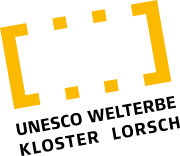
Concept and mission
Unlike at other properties of the State Palaces and Gardens, the finds made at Lorsch are not transferred to a central depot, but left on site. This includes a small collection from the World Heritage Site, as it was once shown in Lorsch in 1991. The same applies to pieces that were moved from Darmstadt to Lorsch in the early 1950s. The main part, however, consists of the collection and depot holdings of the Hessisches Landesmuseum Darmstadt, as they had been exhibited in the church fragment of the monastery since 1956. Finally, the collection was greatly enhanced by the excavation campaigns carried out by the universities of Bamberg and Heidelberg between 1997 and 2015.
Bringing the collections together is not only due to the provenance principle, but also takes into account the expectation that they will be shown, explained, researched and categorized in their authentic location. Here the claim of the World Heritage Site to also be a research museum becomes very clear.
The objects in the Zehntscheune document impressive finds from 200 years of excavation history. In addition to late antique pieces from the 2nd and 3rd century as well as Carolingian columns and capitals from the monastery’s heyday, there are also a large number of important small finds that reveal revealing contexts of monastic life.
The old barn doors were replaced with solid steel doors as part of the renovation of the entire site in 2011-2015. Thanks to the use of a dark-colored concrete floor and the separate black ceiling, the Zehntscheune show depot now looks like a black box. Only individual stone fragments are brought to life during the tour by light spots via a tablet control system. Visitors are taken on a journey of discovery into the history of the monastery in the Zehntscheune show depot. By deliberately not labeling the exhibits, the aim is to stimulate the spirit of discovery and deliberately create space for visitors’ own associations.
